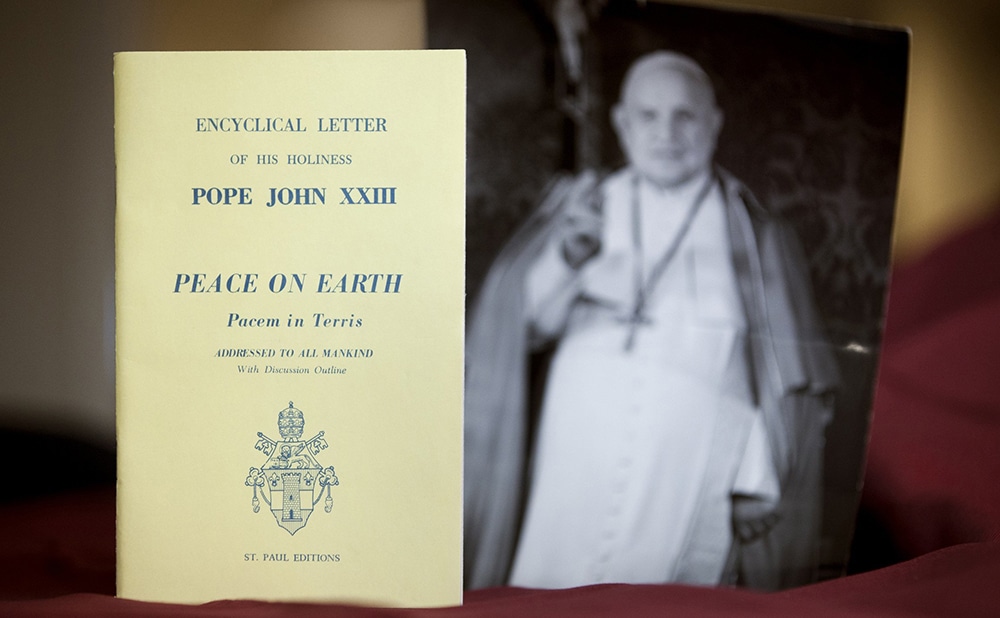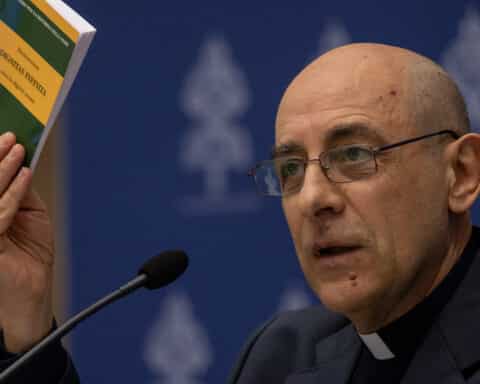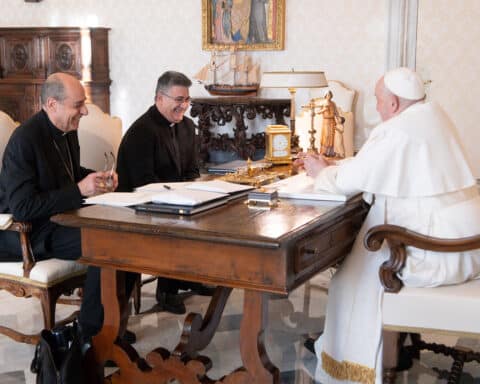In the middle of October 1962, Pope St. John XXIII spent a sleepless night composing what he intended to be a letter to President John F. Kennedy and Soviet Premier Nikita Khrushchev. The two leaders and their countries were locked in what became known as the Cuban missile crisis. The pope, understanding the catastrophic consequences of a U.S./Soviet war, became an emissary between the two men in order to encourage a peaceful outcome. He also read a message on Vatican Radio urging the countries to choose conversation over confrontation.
The pope’s message was repeated in media outlets worldwide. On Oct. 28, the crisis ended when the Soviets agreed to remove the missiles from Cuba and the U.S. promised not to invade the island (which depended on Soviet aid). Less than a year later, on April 11, 1963, Pope John XXIII released his encyclical Pacem in Terris, calling this time for peace on the entire Earth.
Context
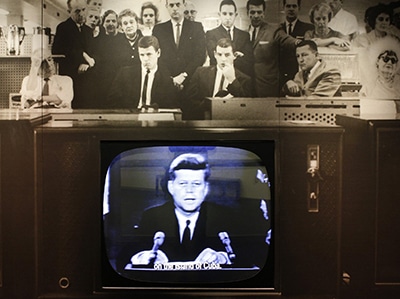
It’s clear that the Cuban missile crisis was the main impetus to the writing of Pacem in Terris. But there were other concerns. The Cold War, during which the United States and the U.S.S.R. vied for power and influence in places like Germany, Hungary and Korea, remained ongoing, and, therefore, so did the looming threat of nuclear war. Civil unrest increased as well, with citizens demanding accountability and transparency from their leaders and governments.
Even within the Church, disagreements soiled the fraternity and charity members were called to practice. The opening of the Second Vatican Council on Oct. 11, 1962 (even as the Cuban missile crisis was beginning), was met with opposing views from prelates regarding the Church’s stance before modern times: defensive versus pastoral. The trajectory on which the world was headed pointed toward more conflicts, which is why Pope John XXIII wanted to remind the world of another way to live together on this planet.
Content
The pope asserts in Pacem in Terris that the human person — and by extension, society — has the capacity to choose peace. He addresses his message to all people of goodwill: Everyone, throughout the ages, has longed for and sought after peace on Earth (cf. No. 166). This desire is not misplaced, for peace is attainable “by diligent observance of the divinely established order” (No. 1).
The divine order can be discerned and followed by the human person because human nature — as created by God — includes intelligence and free will. With the gift of reason, man perceives the order within the universe and within himself (cf. Wis 13:1-9). Observing the divine order in creation enables man to harness the forces of nature for the benefit of mankind — that is, “the plain lesson which the progress of modern research and the discoveries of technology teach us” (No. 2). Likewise, observing the order within himself, man can live in harmony with others and build a society that works for peace.
Read more from our Church Document series here.
Man observes the divinely established order by recognizing and following its corresponding laws that regulate the universe and govern man’s relationships, which the encyclical lists in four groups: relationships between individuals; between individuals and the public authority; between states; and between individuals/states and the world community. Since Pacem in Terris proposes peace among men and women, Pope John XXIII focuses on “the laws which govern man. … The Father of the universe has inscribed them in man’s nature, and that is where we must look for them; there and nowhere else” (No. 6).
The pope is referring to the tradition of “natural law,” which the Catholic Church affirms as part of its official teaching. Natural law “expresses the original moral sense which enables man to discern by reason the good and the evil, the truth and the lie” (Catechism of the Catholic Church, No. 1954). “The natural law, present in the heart of each man and established by reason, is universal in its precepts and its authority extends to all men. It expresses the dignity of the person and determines the basis for his fundamental rights and duties” (CCC, No. 1956).
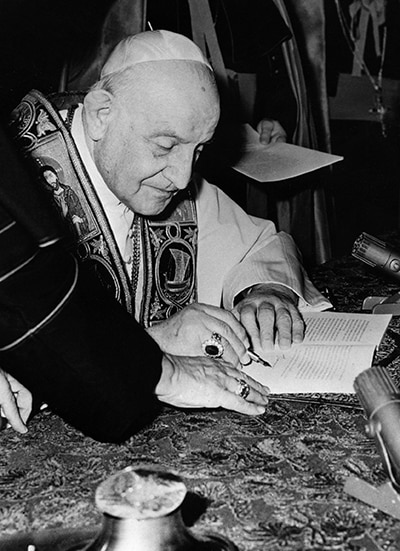
The appeal to the natural law enables the pope to address the wide audience he seeks: all people of goodwill. Indeed, anyone who accepts “that each individual man is truly a person” (No. 9) and that all men and women are equal in dignity and share the same inalienable “rights and duties, which together flow as a direct consequence from [their] nature,” adhere to the natural law.
The consequences follow: Each person has a right to life and the basic necessities to live a healthy, dignified life (food, shelter, clothing, etc.). Each person also has rights within the economic, political and spiritual realms (living wage, legal protection, professing one’s faith, etc.). All of these rights have corresponding duties, and chiefly the duty to recognize the rights of others. The public authority, itself “a provision of divine wisdom” (No. 46), has the duty to work for the common good and to harmonize the rights of individuals with the needs of others (cf. No. 53). In fact, even when considering the relationships between states or among the world communities, the common good cannot be determined without reference to the rights of the human person. The human person remains the subject of society, “its basis and its purpose” (No. 26).
The pope, however, does not fail to include the Christian faith in his argument. He understands that the human community, by itself and despite its good efforts, cannot achieve the peace it longs for. Man can have erroneous opinions (cf. No. 6), governments can pass unjust laws that contravene God’s order (No. 51). Humanity needs God’s assistance (No. 167). So, for those ready and willing to accept it, Pope John XXIII proclaims the inestimable gift of God that makes peace achievable: “Men have been ransomed by the blood of Jesus Christ. Grace has made them sons and friends of God, heirs to eternal glory” (No. 10).
Jesus is the “Prince of Peace.” He “shed his blood to reconcile the human race to the heavenly Father, and bestowed the gifts of peace” (No. 169). By his life of selfless service, his sacrificial death, and his glorious resurrection, Jesus has ushered in the kingdom of God, which is marked by peace and present in the Church and her members (cf. Rom 14:17). Jesus is the one who has observed perfectly the divine order and paves the way for others to follow. Indeed, those who live by his grace (made available in a special way through the sacraments) are able to “pursue what leads to peace and to building up one another” (Rom 14:19). Pope John XXIII ends his encyclical with a prayer to the Prince of Peace: “May Christ inflame the desires of all men to break through the barriers which divide them, to strengthen the bonds of mutual love, to learn to understand one another, and to pardon those who have done them wrong” (No. 171).
Call
The call of Pacem in Terris is very simple in its concept but very challenging in its implementation. Follow the divine order of things, respect the rights of all and fulfill one’s duties; these are the initial steps to peace. If one takes a further step and accepts and lives by the salvation of Christ, becoming an adopted child of God and heir to eternal glory, then one knows by faith that all efforts for peace join in the peace Jesus has already won. Peace on Earth is possible. It will be fully realized when Jesus ushers in his kingdom.
Practicing peace, however, is not so simple. There is no agreement about the divine order of things or the existence of God among the human community. Conflicts erupt in all the relationships of man, from bitter arguments between individuals to threats of war between nations. Indeed, the lack of harmony at every level of society today is just as bad as, or maybe worse than, when Pope John XXIII wrote Pacem in Terris.
But Pope John XXIII did write Pacem in Terris, and he did so in the midst of a frightening conflict inching toward nuclear war. Nevertheless, his efforts at peace influenced two other individual human beings, the leaders of the two countries at odds, to step away from the conflict. Pacem in Terris remains an example of how the individual human person can move towards peace when he or she is actively living by the law implanted in his or her heart. The person may even encounter and come to know the Prince of Peace, sharing in his kingdom.
David Werning writes from Virginia.

